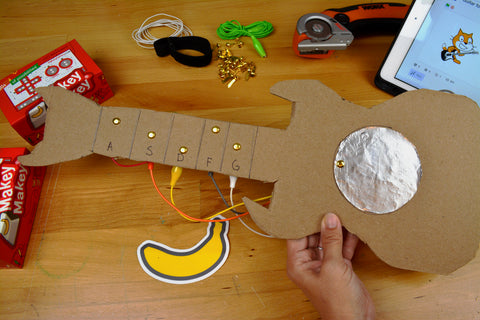This activity allows you to combine Makey Makey and our Interactive Poster app to create an interactive poster. While designing your own interactive poster, you will investigate how circuits work. Plus, you'll begin to think about user interface design and how it is important when designing physical computing projects. Extensions include coding your own poster with Scratch.
| Research Poster Topic |
|
Create a poster about the topic you want to share! You can make an interactive body systems poster, interactive display about an animal, display the life cycle of plants, share great poetry, and more! The possibilities are endless! Once you've researched a topic, design a poster with images and text to display what you've learned. |
|
|
| Create Conductive Touch Points and Finish Poster Design |
|
Use conductive materials to create conductive touchpoints on your poster. When designing a user interface, think about the age of people who will be using your poster to learn about your topic. User interface design is an important stage in inventing!
First decide what materials you want to use to make conductive touch points on your poster. You can use pencil lead (we prefer 6B pencils which have heavier graphite than your average pencil), metal paperclips, tin foil, etc. (Want to know what items are conductive? Check out this project to learn more.)
Download and print this conductive materials list!Metal ThumbtacksYou can use metal thumbtacks for conductive touch points. Press into cardboard and connect alligator clips on the back of the poster.
Back of the PosterWe added styrofoam on the back of our poster to stabilize it since the alligator clips add bulk. Think about how you want to frame your poster so users can press conductive touch points and your poster maintains stability.  Close up
Pencil DrawingPencil drawings work great as conductive touchpoints, but the graphite might come off on your fingers and you may have to redraw your circuits over time. Make sure lines are dark and thick and that the alligator clip is connected directly to the pencil drawing.  Brass FastenersThis is one of our favorite supplies for creating conductive touchpoints! Press the fastener through your poster and fold the legs of the fastener on the back so you can clip your alligator clip directly to the fastener on the back of the poster.
Mixed Items!You can always mix items, but make sure that your user knows how to play sounds on your poster!
Full How To Video for this ProjectYou can record your audio directly into our Makey Makey Poster App, Sampler App, or record and code audio in Scratch. |
| Recording Sounds |
|
If you are recording poetry, make sure your voice matches the mood and tone of the poem you are sharing. Practice what you will record multiple times before recording. Makey Makey SamplerYou can record your voice samples in our Sampler app and connect straight to Makey Makey for a plug and play experience! Click on the microphone to record. Press and hold to record. (You have a limit of five seconds)
Press to test your sample, and click on the sound wave to trim.
Name your sample and save it to the library. (It will only be stored for this session, so if you like all your recordings and want to use them again. Make sure to export your sample pack once you have all your samples recorded and placed on the sampler. (Video tutorial) |
|
|
Extensions |
|
Now that you've made an interactive poster, try out some of these projects.
|
|
|
Supplies
- Makey Makey Classic
- Posterboard
- Conductive Material List
- Conductive Materials: Brass fasteners, metal thumbtacks, 6B pencils





























